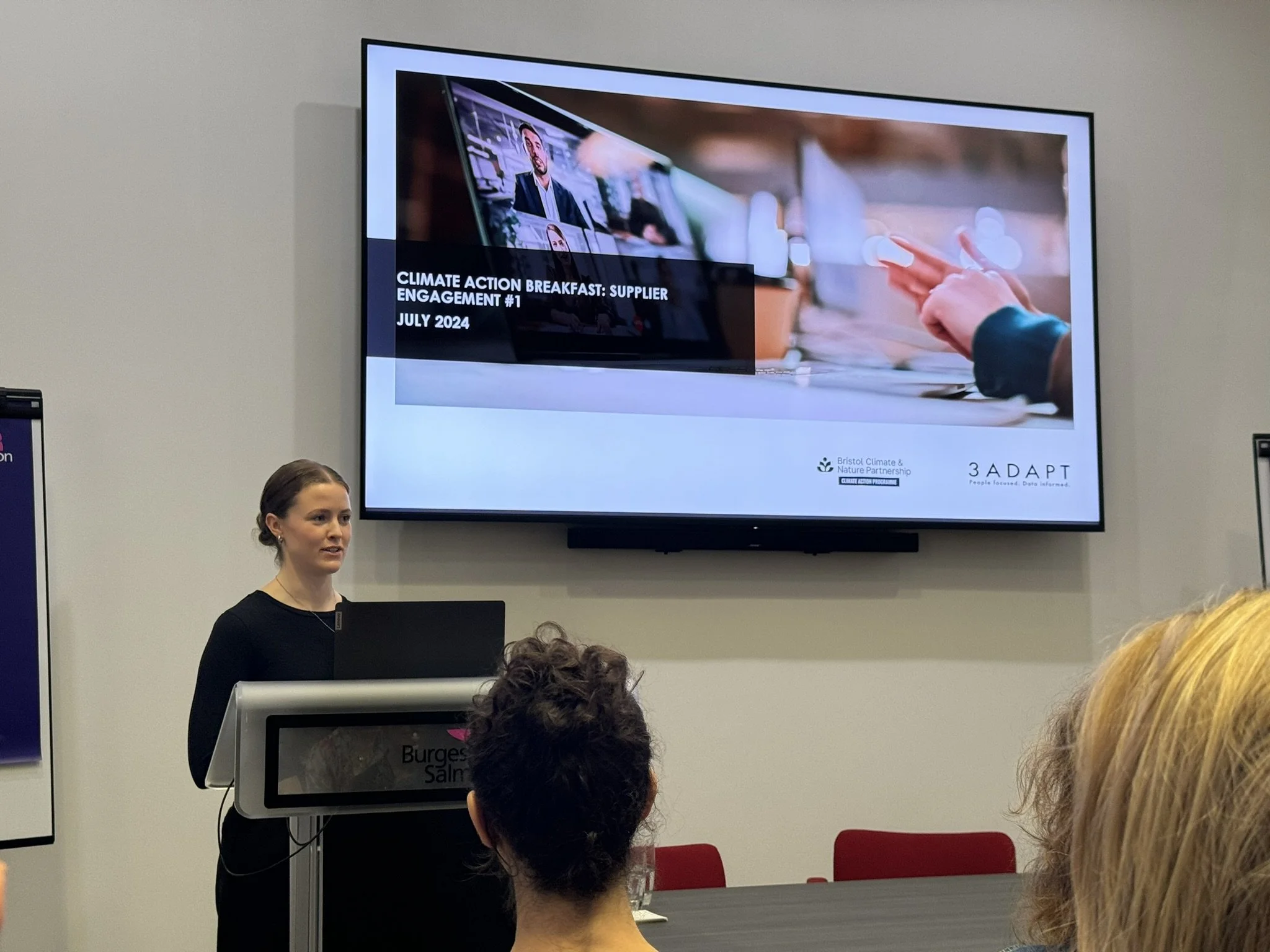The last few years have seen a significant shift in where organisations are focusing their sustainability efforts. Many of our clients have begun to move from simply accounting for carbon emissions to taking action to reduce them. For many organisations, net zero target years are fast approaching and there is an urgent need to address emissions. With procurement often being one of, if not the, largest source of emissions for most organisations, there is a growing focus on establishing processes for sustainable procurement and beginning to engage with suppliers.
On the 17th July, Rhian from 3ADAPT had the pleasure of speaking at the first Climate Action Breakfast on supplier engagement hosted by Bristol Climate & Nature Partnership. The breakfast was the first of two introductory sessions focusing on practical steps and actions organisations can take to begin navigating this complex, but exciting, space.
As well as outlining a structured process for effective supplier engagement, the session included an overview of why supplier engagement is important, how to map the supply chain, getting internal buy-in and setting goals for supplier engagement. Key takeaways from the talk are summarised below.
Image caption: Rhian from 3ADAPT started the morning with a talk on sustainable procurement at the Bristol Climate Action Breakfast.
Why Supplier Engagement is Important
Supplier engagement is crucial for several reasons. It enables better understanding, measurement and reporting of sustainability impacts within your supply chain and provides the opportunity to ensure that suppliers align with your sustainability targets. By engaging with suppliers, organisations can identify the current maturity of their supply chain and how much support might be required to assist suppliers in aligning with targets. Supplier engagement not only drives improvements, but also builds credibility with key stakeholder groups, demonstrating a commitment to responsible practices.
A Structured Process for Supplier Engagement
Image caption: The 8-step supplier engagement process outlined by 3ADAPT to drive sustainable procurement
3ADAPT outlined a structured process for supplier engagement, using the following 8 steps:
Map Supply Chain: establish your baseline and map your supply chain to identify priority areas and hotspots.
Get Buy-in: identify key internal stakeholders and establish buy-in.
Set Goals: establish a supplier engagement goal.
Establish Methodology: establish methodology for collecting and managing supplier data.
Engage: carry out ongoing engagement with suppliers and provide support where needed.
Embed in Procurement: incorporate sustainability-related considerations throughout the procurement process.
Track Progress: track progress and performance towards goals.
Review and Improve: review processes and goals and make adjustments according to changes to supply chain, regulations, ambitions, etc,.
As the first of two Climate Breakfasts on supplier engagement, this session focused on stages 1-3 of the process.
1. Map the Supply Chain
Developing a robust understanding of your supply chain enables prioritisation of suppliers and is key to effective supplier engagement. This can be achieved through:
Ranking suppliers: Suppliers can be ranked according to either total spend or total carbon emissions. This provides an initial high-level view of where key hotspots may be. The ranking can be used to identify how many suppliers you would need to engage with to achieve a desired coverage of emissions. We usually find that you only need to engage with a relatively small proportion of total suppliers to get a good coverage of emissions. For one of our recent clients, we found that just 20 (of 1,500+) suppliers accounted for ~50% of total emissions from purchased goods and services.
Selection criteria: Consideration of additional factors can help to further refine and prioritise suppliers for engagement. This could include consideration of current supplier maturity, the type or size of supplier, how much leverage your organisation has over the supplier, contract renewal date and whether they are a recurring supplier.
2. Get Buy-in
Engaging with and getting buy-in from key internal stakeholders is crucial in achieving supplier engagement goals. It is essential that all relevant stakeholders are engaged in the process, understand the targets and their role and responsibilities going forward. Things to consider include:
Stakeholder interests and concerns.
The level of sustainability knowledge the specific stakeholder may have and what support may be required.
How the benefits of supplier engagement should be framed for the stakeholder.
What stage in the process it would be useful to get their buy-in or input.
Whilst there are several key stakeholder groups that should be engaged throughout this process, we have found that working directly with the Heads of Sustainability and Procurement enables effective and efficient supplier engagement through drawing upon and aligning two crucial skillsets.
3. Set Goals
Setting goals for supplier engagement helps to provide clarity around what you are trying to achieve and establishes direction and accountability. The type of goal that you set will depend on the type of data that you currently have relating to your supply chain. Broadly speaking, there are three approaches to setting goals for supplier engagement, as follows:
Absolute Emissions Reduction: A target for a percentage reduction in emissions associated with your supply chain by a target year. This approach is only applicable if you have already moved away from a purely spend-based approach for quantifying procurement emissions toward collecting product or supplier-specific data. This is because a spend-based approach doesn’t take account of actions your suppliers are taking to reduce their environmental impact.
Emissions Intensity Reduction: Similarly to approach 1. this is a target for a percentage reduction in emissions by a target year. However, in this approach, emissions are normalised using a metric such as unit of product purchased or £ spent. This enables business growth whilst reducing emissions intensity. Again, this approach requires you to be using product or supplier-specific data.
Supplier Engagement: If you have not yet started to collect granular data from your suppliers, a supplier engagement goal can still be useful to direct efforts. This is a goal to engage with a specific population of suppliers to set their own net zero targets or science-based targets by a target date. This is where the mapping exercise described above is useful for informing the type of target that might be feasible based on the current maturity of suppliers.
Summary
It was great to have so many people in the room interested in supplier engagement and to hear about both the approaches taken and challenges faced by other organisations. We hope that everyone left with some practical ideas to take forwards and we are looking forward to the second session on Friday 27th November which will explore stages 4-8 of the supplier engagement process. This will include discussion of methodologies for data collection and engagement as well as how to embed sustainability-related considerations within the procurement process.
To join us for Part 2 at Bristol’s Climate Action Breakfast at Burges Salmon, sign up as a Partnership member here to receive full event details.
Get in Touch
We invite you to reach out and explore how 3ADAPT can support your journey toward more sustainable procurement practices. Whether you’re looking to refine your supplier engagement strategy, set actionable goals, or navigate the complexities of sustainability reporting, our team is here to help.
About 3ADAPT
At 3ADAPT, we have a track record of promoting sustainability with major organizations like the Woodland Trust, Eden Project and Kew Gardens. We support public, private, and third sectors in achieving sustainability goals. Our expertise spans net-zero carbon initiatives, climate change adaptation, ecology, and more, ensuring sustainability is at the core of everything we do.





